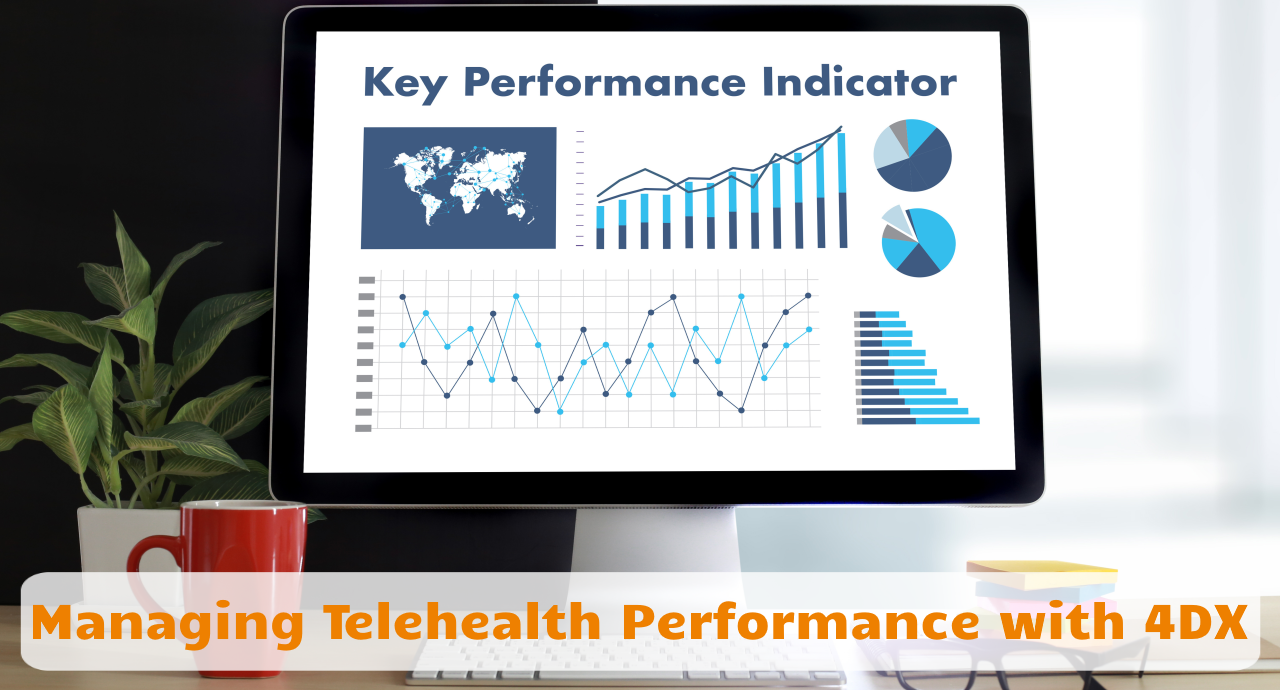In many healthcare organizations, telehealth is but one of many things its leadership team should pay attention to. But with nursing staffing shortages, physician burnout, and decreasing funding streams, telehealth — “this thing we had to do during Covid” — is on very few leaders’ minds as a solution to many of their current challenges.
But as I laid out over the past months, telehealth can be used…
…to address the nursing shortage
…to add to the bottom line to increase revenue, reduce losses, and decrease cost.
and help your organization to improve health outcomes and to stay competitive.
Once properly understood, telehealth is a powerful strategic tool that can strengthen the organization in many aspects.
Once healthcare leaders understand, accept, and then embrace this premise, the next question becomes: how do I prepare my health center, my clinic, my health system to embrace virtual visits more? And how would I know that we are making progress?
In short: What are the critical metrics to measure telehealth success?
On The Importance of Keeping Score
Before we address that question, let me first introduce the importance of measuring success.
Over the past two decades a change in executing strategy has quietly swept through thousands of organizations from departments at Fortune 50 companies to government agencies. The approach, labeled 4DX, promotes four key disciplines for an organization to follow to make a significant change.
To achieve great results, teams must follow these four disciplines:
- Discipline 1: Focus on the Wildly Important
- Discipline 2: Act on the Lead Measures
- Discipline 3: Keep a Compelling Scoreboard
- Discipline 4: Create a Cadence of Accountability
For more detail on these principles, see FranklinCovey’s excellent overview of the approach.
While I have written about the importance (and the mechanics) of measuring telehealth success in the past (see this resource page with a list of past articles and a downloadable white paper), I want to focus in this article on implementing a telehealth success management system that is built on the principles promoted by 4DX.
Discipline 1: The WIG
If the term “WIG” evokes images of either judges in dusty-smelling hair pieces (also called bench wigs) or fond memories of a distant relatives toupée, fear not! Wildly Important Goals are much more attractive and useful!
For the first of the four disciplines, I postulate as the Wildly Important Goal “The full integration of virtual care as a viable alternative care delivery method.”
While you may adopt the phrasing to the priorities and culture of your organization, the key point of this definition is the “full integration”. This speaks to both acceptance by the clinicians (who can be a bit obstinate about embracing virtual care) and the integration of the virtual care workflows.
By the way, in this context I care very little about any insisted-on technology integration. In most cases the lack of (or cumbersome) technical integration is blown out of proportion. One of the best explanations is that it is easier for technophiles to blame vendors for the lack of interfaces or integration than it is to design intelligent workflows and provide appropriate training. Oh, and using the same vendor for two pieces of technology (say, telehealth and the EHR) does not ensure interoperability or smart integration…and it also may not provide the most clinician-friendly user experience. But I digress.
Discipline 2: Act on the Lead Measures
In measurement, lag measures describe the outcomes and are often only attained many weeks or months after events (such as a visit) took place. They are thus not very useful in the day to day management of a service, as they are lagging behind.
Leading measures, on the other hand, are those that can quickly tell a leader how well you are making progress toward achieving your WIG or not.
For many years now, we have focused on the following 5 key virtual care performance metrics as a great starting set:
- Patient Satisfaction
- Clinician Satisfaction
- Technical Performance
- Volume & Modality
- Reimbursement
Let’s look at the lead and lag characteristics of each one of them:
Patient Satisfaction — depending on how it is obtained, it can be a great lead measure. If it the capturing of patient satisfaction is obtained right after the virtual visit (ideally as an integral part of the virtual care solution at the end of the visit), this metric (when matched with other attributes, such as the clinician, the location, and the specialty) can provide excellent leading insights as to whether you are achieving “full integration” with this location, with this clinical specialty, or with this particular physician.
Clinician Satisfaction — a little harder to obtain since we can’t really expect clinicians to complete a survey after each and every visit (and we suggest to collect satisfaction quarterly as a snapshot to “take a pulse”). A more “lead like” measure would be a quick single yes/no question at the end of each visit: “Did you encounter any problems?” In the case of “Yes”, the provision of additional information would be optional, but this simple question could provide very actionable insights.
Technical Performance — I always say: “Virtual Care is not about Technology, except when it is.” Good technical performance and usability is these days expected as the bare minimum, but oftentimes technical problems and glitches get in the way – especially on the patient end. The challenge with this metric is that it oftentimes is not collected every time a problem occurs and reporting even from the best IT issue tracking system is oftentimes cumbersome. A single question like the one above yields much more actionable data, especially if one of the follow-up questions to “Yes, I experienced problems.” would be a nested series of multi-choice questions about the technology.
Volume & Modality — this metric should be super easy to obtain and it provides a very good insight into any fluctuations or growth of service adoption. Further analysis could correlate the use of virtual care to the patient’s zip code (to get the distance) or the weather conditions (e.g., snow & ice). You would have to agree on what percentage of volume (vs. in-person) would constitute “fully integrated”. A 50:50 mix for every provider may be a stretch goal for now but would certainly indicate “full integration”. Modality is about video vs. audio, which is more relevant when it comes to reimbursement, as payment for audio-only may go away in many circumstances.
Reimbursement — While this is a key metric for telehealth performance, it is not as relevant for the proposed WIG. If the WIG, however, would talk about leveraging telehealth to add to the bottom line, grow top line revenue, expand geographic reach, or attract more patients, then reimbursement could play a “lead” role in assessing the performance of virtual care (in relation to the WIG).
Other lead measures: Given the Wildly Important Goal, one of the initial lead measures that an organization should track also includes what percentage of all clinicians (and other workflow actors) have been trained – on the workflows, on the technology, on webside manners, etc. On a higher level, a lead measure in a health system could also track how many locations and specialties have been trained and are using telehealth (e.g., at least 10% or 20% of the time).
Discipline 3: Keep a Compelling Scoreboard



Similarly, we need to make it easy for the team to see whether (and how much) they are winning. How do you know how much closer you are getting to achieving your wildly important goal?
This is where the lead measures that you have identified in the previous discipline need to be collated and displayed in an easy to see and easy to understand scoreboard. A well designed scoreboard makes it clear what the metric is, when it was collected, and how close we are to “winning”.
By nature, we humans are competitive, and “keeping score” is a fun (if not even a “bonding”) experience that all leaders can use to bring their team together around a common, shared objective!
Discipline 4: Create a Cadence of Accountability
While it is fun to look at successful scores, it is interestingly even more exciting, if there are consequences – both for positive and for negative outcomes (especially for negative outcomes). Why? if there is nothing at stake, then it’s quite boring.
Imagine the Soccer World Cup trophy being handed out based on a random lottery-style drawing after the end of all the teams playing each other. A ball with the winning country’s flag is selected out of a lottery machine. No super ball here…
Accountability is where the Execution happens, or, as the FranklinCovey overview puts it: “until you apply Discipline 4, your team isn’t in the game”.
Accountability starts with the Ownership of each lead measure. Someone has to take responsibility to make sure the score is moving into the right direction. Someone has to take responsibility for making sure that corrective actions — those that bring the metric back on track in the right direction — are executed and followed through.
At each weekly WIG meeting, the responsible leader (the “someone”) must report on previous commitments — and the action that followed. After that, new commitments are made, based on the performance visible on the scoreboard.
It is important that commitments are made in the form of a specific deliverable that influences a lead measure. And that those commitments are made by people who have full control over keeping that commitment.
Through Discipline to Virtual Care Success
Managing by fact, using data to make decisions and having the discipline to review and act on key performance indicators on a regular basis are key skills that every healthcare organization has to master.
As I laid out at the beginning, the benefits of a well-integrated virtual care offering are manifold and it’s a small enough domain to begin to flex your data-driven improvement muscles.
To learn more about which data-driven improvement approach works best for your organization, check out this article from my colleague Kathy Letendre, who is currently working with one of our health center clients to bring fact-based management to all of their strategic pillars.
Reach out to us, if you’d like to learn more about using 4DX to improve the performance of virtual care in your organization.








To receive articles like these in your Inbox every week, you can subscribe to Christian’s Telehealth Tuesday Newsletter.
Christian Milaster and his team optimize Telehealth Services for health systems and physician practices. Christian is the Founder and President of Ingenium Digital Health Advisors where he and his expert consortium partner with healthcare leaders to enable the delivery of extraordinary care.
Contact Christian by phone or text at 657-464-3648, via email, or video chat.






